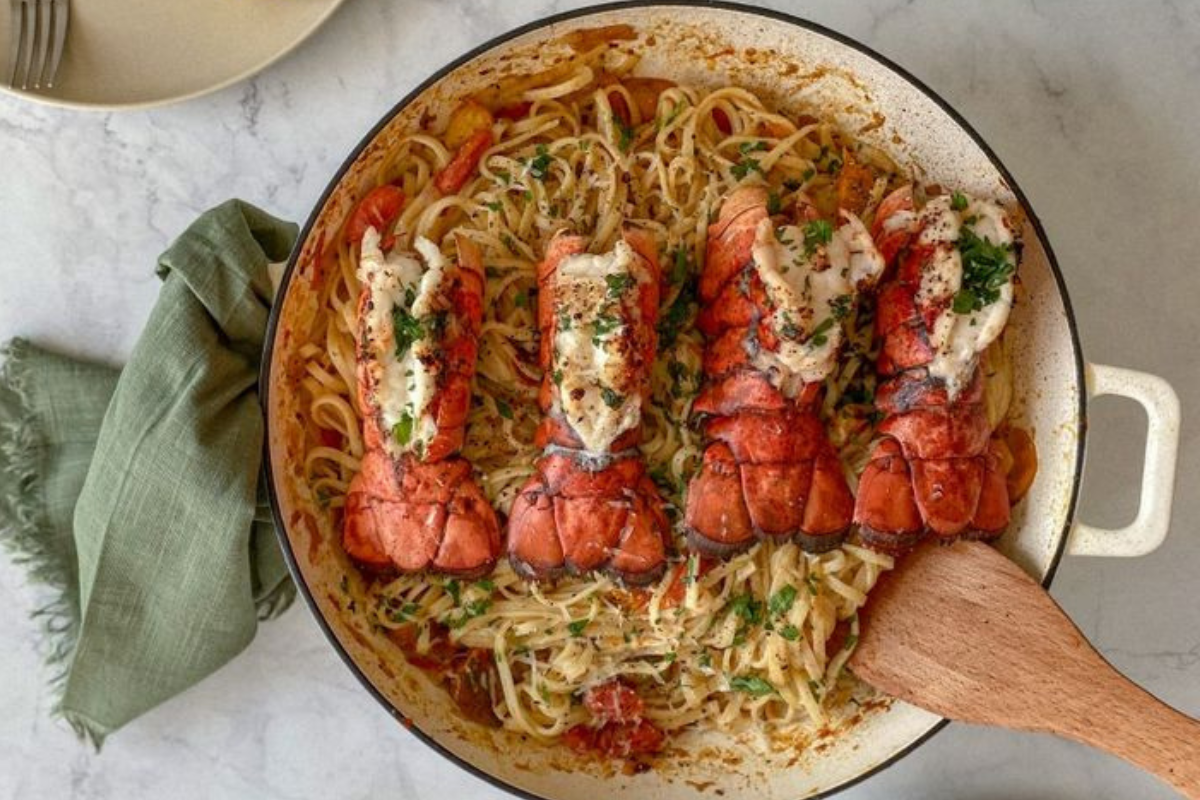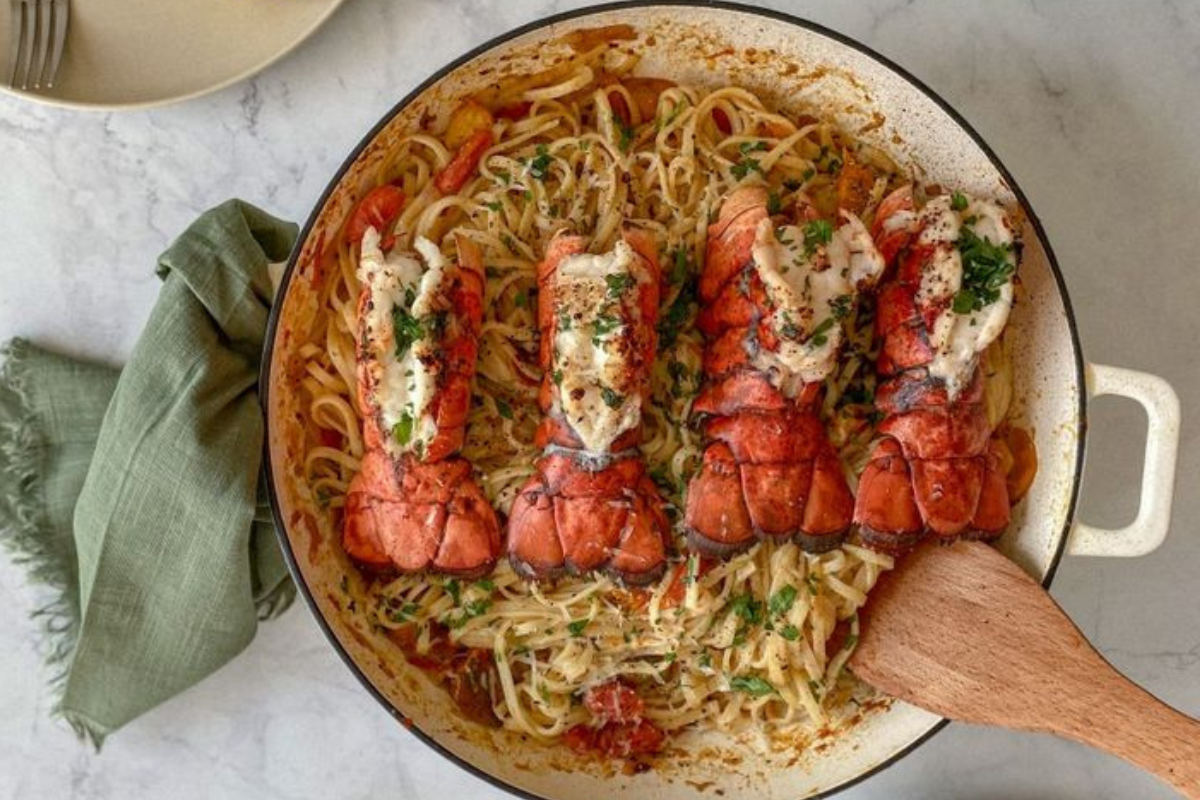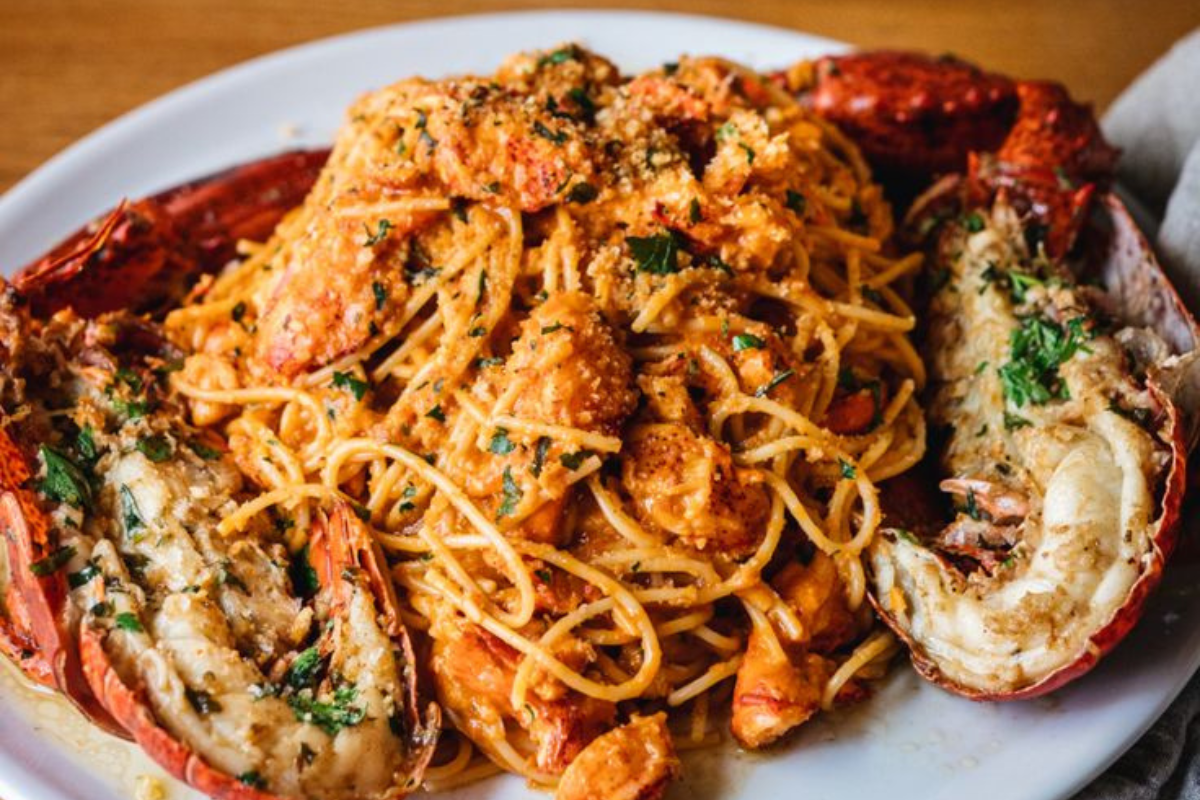Highlighting Key Ingredients
Creating mouth-watering lobster pasta begins with sourcing the best ingredients. Each component plays a crucial role in enhancing the dish’s overall flavor and texture. Here are the key ingredients that make this dish a culinary triumph:
- Lobster: The star of the dish, lobster brings a sweet, rich, and succulent flavor. Fresh, live lobsters are ideal for their superior taste and texture. However, for convenience, pre-cooked lobster meat or even frozen lobster tails can be used.
- Pasta: The choice of pasta is vital to the dish’s character. Linguine or fettuccine are popular choices due to their ability to hold the sauce well. They provide a perfect balance to the chunky lobster pieces.
- Garlic and Shallots: These aromatics are fundamental in building a flavor base. Garlic adds a punch of flavor, while shallots contribute a subtle sweetness.
- White Wine: A dash of good quality white wine enhances the sauce with acidity and depth. It also helps in deglazing the pan to incorporate all the delicious browned bits into the sauce.
- Heavy Cream: The backbone of the sauce, heavy cream contributes to the luxurious, velvety texture that coats the pasta beautifully.
- Parmesan Cheese: Parmesan adds a salty, nutty flavor that elevates the sauce, providing an extra layer of complexity.
- Seasonings: A mix of salt, thyme, tarragon, red pepper flakes, and black pepper is used to perfectly season the dish, adding layers of flavor.
- Garnish: Fresh parsley, lemon zest, and juice are essential for finishing the dish, adding freshness and a touch of acidity.
Variations and Substitutions
- Lobster Alternatives: While lobster is the highlight, you can substitute it with shrimp or crab meat for a different seafood twist.
- Pasta Varieties: While long, flat pasta types are preferred, you can experiment with other shapes, like penne or orecchiette, for a different texture.
- Dairy Substitutes: For a lighter version, replace heavy cream with half-and-half or a mix of milk and a thickening agent like flour or cornstarch.
- Cheese Options: While Parmesan is traditional, try other hard cheeses like Pecorino Romano for a sharper flavor.
- Vegan and Gluten-Free Adjustments: Use gluten-free pasta and replace the lobster with a vegan alternative like king oyster mushroom stems. Substitute dairy with coconut cream and vegan cheese.
- Alcohol-Free Version: If you prefer to avoid alcohol, use chicken or vegetable broth instead of white wine.
- Spice Variations: For those who enjoy a bit of heat, increase the quantity of red pepper flakes or add chopped fresh chilies.
- Vegetable Add-ins: Incorporate vegetables like spinach, asparagus, or peas for added nutrition and color.
Step-by-Step Cooking Process
Preparing the Lobster
- Selecting and Cleaning: Begin with fresh lobsters or pre-cooked lobster meat. If using live lobsters, ensure they are lively and have a vibrant shell. Clean them thoroughly under cold water.
- Boiling the Lobster: Fill a large pot with water, add a tablespoon of salt, and bring it to a boil. Gently place the lobsters in the boiling water and cook for about 8–10 minutes, or until the shells turn a bright red.
- Cooling and Extracting Meat: Once cooked, remove the lobsters and place them in ice water to stop the cooking process. Once cooled, use lobster crackers and picks to remove the meat from the claws, knuckles, and tails.
- Chopping: Chop the lobster meat into bite-sized pieces. Set aside for later use.
Cooking the Pasta
- Boiling Water: In a large pot, bring water to a rolling boil. Add salt generously to season the water.
- Cooking Pasta: Add the pasta to the boiling water and stir occasionally. Cook according to the package instructions until al dente, usually around 7-10 minutes.
- Reserving Pasta Water: Before draining, reserve about a cup of pasta water for later use. This starchy water is crucial for adjusting the sauce’s consistency.
- Draining and Setting Aside: Drain the pasta and set it aside. Optionally, you can toss it with a little olive oil to prevent sticking.
Making the Creamy Sauce
- Sautéing Aromatics: In a large skillet, heat olive oil and add finely chopped shallots and garlic. Sauté until they are translucent and fragrant, being careful not to burn the garlic.
- Deglazing with Wine: Pour in the white wine to deglaze the pan, scraping up the flavorful bits from the bottom. Let the wine be reduced by half.
- Adding Cream and Cheese: Slowly add the heavy cream, stirring continuously. Once the cream starts to simmer, gradually add grated Parmesan cheese, allowing it to melt and blend into the sauce.
- Seasoning: Add thyme, tarragon, red pepper flakes, salt, and black pepper. Adjust the seasonings to taste.
- Combining with Pasta and Lobster: Add the cooked pasta to the sauce, tossing to ensure each strand is coated. Gently fold in the chopped lobster meat. Add a bit of reserved pasta water if the sauce is too thick.
- Final Touches: Finally, stir in a dash of lemon juice and zest for a fresh kick, and sprinkle chopped parsley for color.
Expert Tips for Perfect Lobster Pasta
- Seasoning and Cooking Techniques:
- Salt the Water: Always salt your pasta water well; it should taste like seawater. This is your only chance to flavor the pasta itself.
- Avoid Overcooking Lobster: Overcooked lobster becomes tough. To avoid this, monitor the boiling time closely.
- Sauté Gently: Cook garlic and shallots on low heat to avoid burning, which can impart a bitter taste to the sauce.
- Recommendations for Pasta and Wine Pairings:
- Pasta Choice: Choose a pasta that complements the sauce’s consistency. Linguine and fettuccine work well as they hold the creamy sauce effectively.
- Wine Pairing: A crisp, dry white wine like Chardonnay or Pinot Grigio complements the richness of the lobster. The same wine used in the sauce can be served alongside the meal.
Recipe Variations
- Alternative Ingredients and Flavors:
- Meat Variations: Substitute lobster with shrimp, scallops, or a combination of seafood for a different twist.
- Vegetarian Option: Replace lobster with grilled portobello mushrooms or artichoke hearts for a vegetarian variant.
- Spicy Version: Add more red pepper flakes or a splash of hot sauce for a spicy kick.
Storage and Reheating Guidelines
- Storage: If you have leftovers, store the pasta and lobster separately. Place in airtight containers and refrigerate for up to 2 days.
- Reheating: To reheat, gently warm the sauce over low heat, adding a little cream or pasta water to loosen it up. Add the pasta to the sauce until heated through, then gently fold in the lobster just to warm it. Avoid overcooking to prevent the lobster from becoming rubbery.

FAQs Section
Q1: What type of lobster is best for pasta recipes?
A1: For pasta recipes, it’s best to use fresh, live lobsters for their superior taste and texture. However, you can also use pre-cooked lobster meat or frozen lobster tails as convenient alternatives. The key is to look for lobsters that have a vibrant shell and a fresh sea aroma.
Q2: Can I make lobster pasta with frozen lobster?
A2: Yes, you can use frozen lobster in pasta recipes. Thaw the lobster in the refrigerator overnight before use. Keep in mind that while frozen lobster can be a practical substitute, the flavor and texture might slightly differ from fresh lobster.
Q3: What pasta goes well with lobster?
A3: Long, flat pasta types like linguine or fettuccine are ideal for lobster pasta. They are excellent at holding onto the creamy sauce and provide a good balance with the chunky lobster pieces. However, you can experiment with other pasta shapes as per your preference.
Q4: Can I prepare lobster pasta in advance?
A4: Lobster pasta is best enjoyed fresh, but you can prep some components in advance. You can cook the pasta and prepare the lobster meat ahead of time. However, it’s recommended to make the sauce and combine everything just before serving to maintain the best texture and flavor.
Q5: Is lobster pasta suitable for a dairy-free diet?
A5: Traditional lobster pasta recipes include dairy products like heavy cream and cheese. For a dairy-free version, substitute the cream with a dairy-free alternative like coconut cream and use vegan cheese. The taste will vary, but it will still be delicious.
Q6: What wine pairs well with lobster pasta?
A6: A crisp, dry white wine such as Chardonnay or Pinot Grigio pairs beautifully with lobster pasta. The acidity and freshness of the wine complement the richness of the lobster and the creaminess of the sauce.
Q7: How can I store and reheat leftover lobster pasta?
A7: Store the pasta and lobster separately in airtight containers in the refrigerator for up to 2 days. To reheat, warm the sauce gently, adding a bit of cream or pasta water if needed. Mix in the pasta until heated through, and then add the lobster just to warm it up, being careful not to overcook it.
Serving Suggestions
- To complete your dining experience, consider pairing this dish with a light, refreshing salad.
- For dessert, explore the rich and varied world of brownies, from classic Lemon Brownies to innovative Brownie Sundae, ensuring a delightful end to your meal.
Enjoying Your Meal
- Lobster pasta is best served fresh, but if you have leftovers, they can be stored and reheated without losing much of their original charm.
- End your meal on a sweet note with a variety of brownie options, like the decadent Slutty Brownies, offering a playful twist to your dessert selection.
Why Lobster Pasta is a Must-Try
- Luxurious yet simple, lobster pasta is a dish that balances sophisticated flavors with ease of preparation.
- It offers a unique culinary experience, perfect for special occasions or a delightful gourmet dinner.
- Incorporating insights from Fine Dining Lovers, lobster pasta can be transformed into a dish that rivals those of top chefs.
Creating the Perfect Lobster Pasta
- Key Ingredients: The dish’s charm lies in the high-quality lobster and your choice of pasta. The freshness of the lobster and the type of pasta used can significantly influence the dish’s overall flavor and texture.
- Cooking the Pasta: For an impeccable texture, choose long, flat pasta like linguine or fettuccine. Ensure to cook it to al dente for the best experience.
- The Sauce: A creamy, rich sauce binds the dish together. Add depth and sophistication to your sauce by exploring techniques from Epicurious – Cooking with Wine.
Expert Tips for an Exquisite Dish
- Season your pasta water well for a flavorful foundation.
- Avoid overcooking the lobster to maintain its tender texture.
- Enhance your cooking skills with additional tips from Serious Eats – Perfecting Pasta Dishes.


